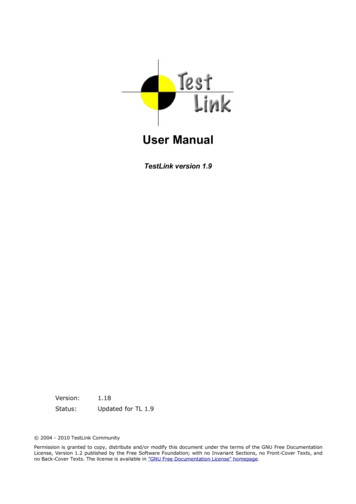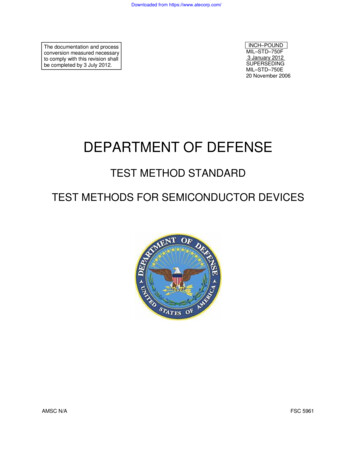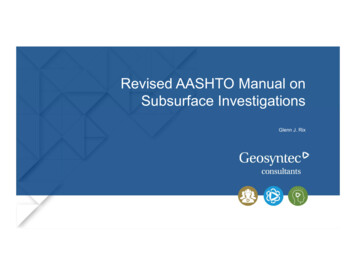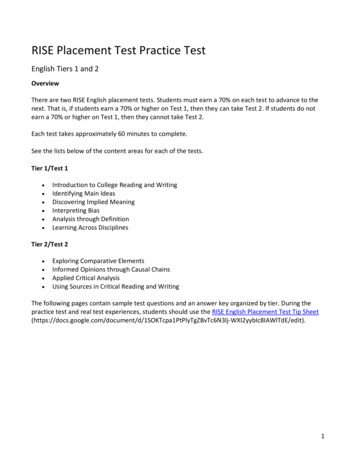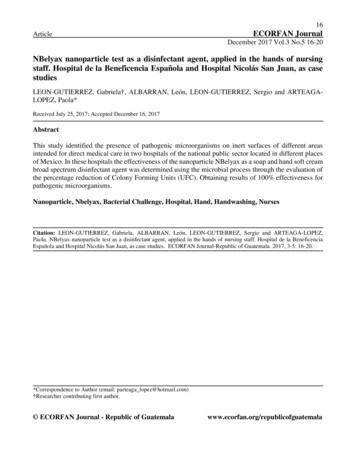
Transcription
16ArticleECORFAN JournalDecember 2017 Vol.3 No.5 16-20NBelyax nanoparticle test as a disinfectant agent, applied in the hands of nursingstaff. Hospital de la Beneficencia Española and Hospital Nicolás San Juan, as casestudiesLEON-GUTIERREZ, Gabriela†, ALBARRAN, León, LEON-GUTIERREZ, Sergio and ARTEAGALOPEZ, Paola*Received July 25, 2017; Accepted December 16, 2017AbstractThis study identified the presence of pathogenic microorganisms on inert surfaces of different areasintended for direct medical care in two hospitals of the national public sector located in different placesof Mexico. In these hospitals the effectiveness of the nanoparticle NBelyax as a soap and hand soft creambroad spectrum disinfectant agent was determined using the microbial process through the evaluation ofthe percentage reduction of Colony Forming Units (UFC). Obtaining results of 100% effectiveness forpathogenic microorganisms.Nanoparticle, Nbelyax, Bacterial Challenge, Hospital, Hand, Handwashing, NursesCitation: LEON-GUTIERREZ, Gabriela, ALBARRAN, León, LEON-GUTIERREZ, Sergio and ARTEAGA-LOPEZ,Paola. NBelyax nanoparticle test as a disinfectant agent, applied in the hands of nursing staff. Hospital de la BeneficenciaEspañola and Hospital Nicolás San Juan, as case studies. ECORFAN Journal-Republic of Guatemala. 2017, 3-5: 16-20.*Correspondence to Author (email: parteaga lopez@hotmail.com)†Researcher contributing first author. ECORFAN Journal - Republic of Guatemalawww.ecorfan.org/republicofguatemala
17ECORFAN JournalArticleDecember 2017 Vol.3 No.5 16-201. IntroductionSince the mid-nineteenth century, chemicalproducts applied to the skin have been used inorder to prevent infections. Semmelweis (1847)introduces the practice of washing hands withchlorinated compounds. Lister, years later;expanded the use of phenolic solutions, both inthe hands and skin of patients and in theinstruments used. (1-6)At present, even when the use ofantibiotics in clinical practice is very broad, theuse of antiseptics has not been eliminated as ameasure to prevent infections; On the contrary,the formulations of old substances such as Iodinehave been perfected and other more elaborateformulations have appeared. (7-9). However lastyear, the Food and Drug Administration (FDA)of the United States, released a statement on anew regulation of the use of antiseptics. The rule,published in the Federal Register of the UnitedStates, "Safety and Effectiviness of ConsumerAntiseptics; Topical Antimicrobial DrugProducts for Over the Counter Human Use"(https://www.gpo.gov/fdsys/pkg/FR 2016-0906 / pdf / 2016-21337.pdf) (10) establishes theprohibition of the use of antiseptic products,based on the recommendations of theSupervisory Committee of Drugs WithoutPrescription (NDAC, by its acronym in English).The previous provision is based on theresults obtained when evaluating theeffectiveness of antibacterial products forwashing, compared with the effectiveness ofnon-antibacterial products; the results showedthat there are no significant differences in theeffectiveness of both. However, when the effectsof the ingredients of these products wereevaluated it was found that they had a high riskof producing reproductive alterations andcancer. In addition to causing bacterialresistance.ISSN-On line: 2414-8849ECORFAN All rights reserved.The studies carried out were in vitro toevaluate the bacterial resistance and in vivo toevaluate the toxicity as endocrine andcarcinogenic disruptors. The in vivo studieswere of the topical or dermal type and thepharmacokinetics, dermal absorption, dermalcarcinogenesis, reproductive and developmentaltoxicity, as well as the hormonal effects wereevaluated.In total there were 19 ingredients thatpresented these effects. The foregoingdemonstrates the need for the use of newtechnologies to cover this field that remainsdeserted, NBelyax is a good alternative since itdoes not need the prohibited ingredients to beeffective against pathogens. As always, NBelyaxis at the forefront since it has been tested indermal toxicity studies and does not presentalterations, as well as its main asset in studies ofchronic and subchronic toxicity and it does notpresent adverse effects when administered. Atthe moment more sophisticated studies are beingdeveloped to evaluate the reproductive andcarcinogenic effects of our product.1.1 JustificationThere is documentary evidence of theimportance of guaranteeing an inhospitableenvironment free of germs, pathogens or withmaximum permissible levels (NMP) accordingto current regulations, so it is currentlyrecommended to conduct environmentalsampling to identify the existence of reaks or in case of trying to incorporate newtechniques or innovative products developedwith Nanotechnology.The case before us is to determine theantimicrobial effectiveness of the products: soapand surgical antiseptic cream for its possibleincorporation in the process of asepsis,sanitization and disinfection of the hands of thenursing staff of both hospitals.LEON-GUTIERREZ, Gabriela, ALBARRAN, León, LEON-GUTIERREZ,Sergio and ARTEAGA-LOPEZ, Paola. NBelyax nanoparticle test as adisinfectant agent, applied in the hands of nursing staff. Hospital de laBeneficencia Española and Hospital Nicolás San Juan, as case studies.ECORFAN Journal-Republic of Guatemala. 2017.
18ECORFAN JournalArticleDecember 2017 Vol.3 No.5 16-201.2 ProblemMaintain safety and hygiene within theframework of the effectiveness of properhandwashing processes using nanotechnologicalinnovation products that reduce the risk ofintrahospital infections caused by the contact ofinfected material and the hands of nurses.3.Cream with NBelyax nanoparticle1.2.1.3 Objectives1.4.1 General objectives3.Identify the presence and control of pathogenicmicroorganisms in the hands of nurses atrandom.Rinsing process and taking the secondsample after washing.Prior taking of the sample with isopos inthe hands of the nursing staff.Application of the cream in handscontaining the NBelyax nanoparticle,allowing it to be absorbed into the skin forapproximately 20 to 40 seconds.Process of taking the second sample afterwashing.Evaluation by means of microbiologicaltechniques and obtaining results.1.4.2 Specific objectives Training and supervision of the properhand washing process.Determine the quantitative value of germsbefore and after the application of surgicalsoap and antiseptic cream with theNBelyax nanoparticle.Determine the antimicrobial activity of theproducts with the NBelyax nanoparticle inhands, by applying the microbiologymethod.To determine the correct performance ofthe safety and hygiene processes as well asthe effectiveness of products with theNBelyax nanoparticle.2. Materials and methodsThe process of applying soap and cream to thenursing staff was as follows:Soap with NBelyax nanoparticle1.2.Prior taking of the sample with isopos inthe hands of the nursing staff.Hand washing with the soap, whichcontains the NBelyax nanoparticle, with aduration of approximately 20 seconds.ISSN-On line: 2414-8849ECORFAN All rights reserved.3. ResultsHospital of the Spanish Beneficence ofTorreónSpanish Beneficence TorreónGraph 1Graph 1 shows the results of the effect ofthe use of surgical grade soap and antisepticcream in hands. The results show the differencesbetween the before and after use of both productson the final UFC count of mesophilic organisms,coliforms and yeasts present in the hands of thenursing staff of the Hospital de la BeneficenciaEspañola in Torreón. It was observed that adecrease to zero of CFU is obtained after theapplication of both products.LEON-GUTIERREZ, Gabriela, ALBARRAN, León, LEON-GUTIERREZ,Sergio and ARTEAGA-LOPEZ, Paola. NBelyax nanoparticle test as adisinfectant agent, applied in the hands of nursing staff. Hospital de laBeneficencia Española and Hospital Nicolás San Juan, as case studies.ECORFAN Journal-Republic of Guatemala. 2017.
19ECORFAN JournalArticleDecember 2017 Vol.3 No.5 16-20Nicolás San Juan Hospital of the State of MexicoNew techno-scientific evidence wasobtained as novel disinfection tools that canreplace those products banned by the FDA. It isimportant to highlight the usefulness of reducingthe presence of pathogenic organisms during thehand-washing process of medical personnel ingeneral, particularly in hospital units that assistin procedures aimed at the prevention, controland epidemiological surveillance of Nosocomialinfections.5. ReferencesGraph 2Graph 2 shows the results of the effect ofthe soap and surgical grade antiseptic cream inhands on mesophilic organisms. The resultsshow the differences between the before andafter use of both products on the final UFC countof mesophilic organisms, coliforms and yeastspresent in the hands of the nursing staff of theNicolás San Juan Hospital in the State ofMexico. It was observed that a decrease to zeroof CFU is obtained after the application of bothproducts.4. Discussion and ConclusionsThe results obtained in this study, give evidenceof the bactericidal effect of the NBelyaxnanoparticle in its modality as soap and creamdevelopment. The results of the sampling in twohospitals, evidence the reduction of CFU ofmesophilic bacteria, coliforms and yeast presentin the hands of the nursing staff of both hospitals.The results support the bactericidal effectivenessof the NBelyax nanoparticle.It is concluded that the study objectiveswere fulfilled and the bactericidal effect of theNBelyax nanoparticle is based on the results ofthe microbiological study carried out. The studyinvites to develop later ones to broaden themicrobiological spectrum of action.ISSN-On line: 2414-8849ECORFAN All rights reserved.[1] Nosocomial Infection Surveillance. 1984.MMWR CDC Surveill Summ 35 (No.1ss): 17ss,1986. 20 -21.[2] Wenzel RP, ed. Prevention and Control ofNosocomial Infections. 2nd ed. Baltimore:William & Wiekins; 1993. 15 -17.[3] Edmond MB, Wenzel RP: Infection Control,Mandells Infections Diseases, Principles andPractice of Infection Diseases. 4th Edition.Churchill Livignstone Inc. 1995, New Infecciones Hospitalarias. Editorial MédicaPanamericana. 2ª Edición. Bogotá.1999: pg 78.[5] International Society for Infectious Diseases,Guía para el control de infecciones en el hospital,Boston MA. USA, 2000.pg 45.[6] Haley RW, Shaberg DR et al. Estimating theextra charges and prolongation of hospitalizationdue to intrahospitalization infection: acomparison of methods. J. Infect. Dis. 1980;141248[7] Crede W, Hierholzer WJ Jr. Linking hospitalepidemiology and quality assurance: seasonedconcepts in a new role. Infect Control 1988;9:42.LEON-GUTIERREZ, Gabriela, ALBARRAN, León, LEON-GUTIERREZ,Sergio and ARTEAGA-LOPEZ, Paola. NBelyax nanoparticle test as adisinfectant agent, applied in the hands of nursing staff. Hospital de laBeneficencia Española and Hospital Nicolás San Juan, as case studies.ECORFAN Journal-Republic of Guatemala. 2017.
20ArticleECORFAN JournalDecember 2017 Vol.3 No.5 16-20[8] Gaynes RP, & Horan TC. Surveillance ofIntrahospitalaria Infections. In Mayhall CG.Hospital Epidemiology and Infection Control.Williams & Wilkins, Baltimore. 1996. Pp10171031.[9] Edmond MB & Wenzel RP. InfectionControl. In Mandell G, Bennett J, Dolin R.Principles and Practice of Infectious Diseases.Churchill Livingstone New York. 1995. pp25722575.[10] Safety and Effectiviness of ConsumerAntiseptics; Topical Antimicrobial DrugProducts for Over the Counter Human Use(https://www.gpo.gov/fdsys/pkg/FR 2016-0906/pdf/2016-21337.pdf)ISSN-On line: 2414-8849ECORFAN All rights reserved.LEON-GUTIERREZ, Gabriela, ALBARRAN, León, LEON-GUTIERREZ,Sergio and ARTEAGA-LOPEZ, Paola. NBelyax nanoparticle test as adisinfectant agent, applied in the hands of nursing staff. Hospital de laBeneficencia Española and Hospital Nicolás San Juan, as case studies.ECORFAN Journal-Republic of Guatemala. 2017.
Beneficencia Española and Hospital Nicolás San Juan, as case studies. ECORFAN Journal-Republic of Guatemala. 2017. 1. Introduction Since the mid-nineteenth century, chemical products applied to the skin have been used in order to prevent infections. Semmelweis (1847) introduces the practice of washing hands with chlorinated compounds.
